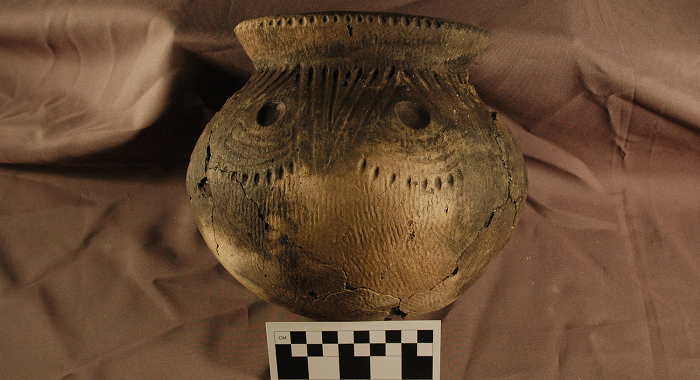
CMC Blog
[Carbon] Dating in the 21st Century
By: Bob Genheimer, Curator of Archaeology

The Fisher Phase pottery vessel as it was found in a trash-filled storage pit.
As an archaeologist, one of the most frequent questions that I am asked is “how do you know how old something is?” There are many different answers to that question, mostly depending on what exactly we are trying to date. Knowing how old something is, even if the age is approximate, is important, because without controlling for time, archaeologists can say little about the culture they are studying.
In general terms, archaeologists rely on two methods of dating – relative and absolute. As the name implies, relative dating relies on a known relationship between the object you want to date and other objects or features in the same or similar context. So, when we pick up a corner-notched spearpoint with a ground base, we know that it is Early Archaic (ca. 8000-6000 BC) in age because large numbers of these points have been found in an Early Archaic context. Or, when an artifact is found well below another in context with undisturbed strata, we can say that the first is older than the second. As you can see, relative dating is not precise, and it makes assumptions based on the reliability of secondary information. It is, however, helpful, and remains the most common dating technique in archaeology today.
Absolute dating, although certainly not absolute, attempts to directly or indirectly date an object or remains through the application of scientific methods. While there are many different types of absolute dating, in American archaeology, the most consistently used is the radiocarbon dating method. The rationale behind radiocarbon dating is actually quite simple. C14, an isotope of carbon, is taken up by living plants (and, hence animals who eat them) while they are alive, and after death, C14 undergoes a known rate of decay. So, if you can measure the amount of C14 left in organic material, you should be able to estimate its age. The method is complicated by fluctuations in atmospheric C14 through time, but through the study of tree rings and other methods, scientists have developed calibration curves that can be applied to radiocarbon results.
The sticking point with radiocarbon dating is that you can only directly date organic material. But, while your radiocarbon date is for a fragment of a carbonized nut or corn kernel, what you are actually trying to do is date the context where it was found and any artifacts that are associated with it. Let’s look at an example from the Cincinnati Museum Center’s Hahn site field school this summer.
Examples from Hahn

The Fisher Phase pottery vessel after reconstruction in the lab. Note the wide range of decorations.
While digging a trash-filled storage pit at the edge of the Hahn site, a complex of Fort Ancient villages located in Anderson Township, we encountered a large section of a pottery vessel at about three feet in depth below the surface. When we pulled the pot from the feature and flipped it over, we noticed it was heavily decorated, but not in the style of Fort Ancient pottery. What we had was a vessel from the Oneota culture, various groups that lived in the eastern Plains and the Great Lakes region hundreds of years ago. Our particular vessel appeared to be most aligned with the Fisher phase, from the 13th through the 15th century AD.
Our first task was to use relative dating. We knew the approximate age range of Fisher ceramics, so we looked at what else was in this pit feature. What we found were numerous examples of decorated pottery sherds that are diagnostic to the middle Fort Ancient period (ca. AD 1200-1400). This suggested strongly that the age of the vessel fell within that period, but to be sure we turned to absolute dating.
From the same level as the Fisher vessel, we recovered a small fragment of a carbonized nut hull that weighed only 0.2 grams. While this sounds small, it is more than enough to do radiocarbon dating with an accelerated mass spectrometer, a device that can literally count all the C14 atoms within the nut fragment. The returned conventional radiocarbon age was 520 +/- 30 BP, where BP stands for “present”, which is frozen at 1950. In calendar years, this translates to AD 1430. When imposed upon known calibration curves at two standard deviations, two intercept points are noted – the first from AD 1330 to 1340, and the second from AD 1395 to 1440. Given that this type of Fisher vessel is known from earlier Fisher context, the earlier intercept is most likely more accurate. Again, we have used both relative and absolute dating to obtain a more precise date for the vessel.
You should start dating
Are you interested in participating in the Museum’s 2019 Hahn field school in July? Sign-ups are open now.
Museum Admission
Includes Cincinnati History Museum, Museum of Natural History & Science and The Children’s Museum.
| Adult (13+): | |
| Senior (60+): | |
| Child (3-12): | |
| Member Adult: | FREE |
| Member Child: | FREE |
Members receive discounts!
Become a Member today to save on programs, exhibits and films throughout CMC.
Museum Hours
Open Thursday – Monday
10 a.m. to 5 p.m.
Closed Tuesday and Wednesday
Closed Thanksgiving Day and Christmas Day
Member’s-only early entry: Saturdays at 9 a.m.
Customer Service Hours:
Monday – Sunday, 9 a.m. to 5 p.m.



